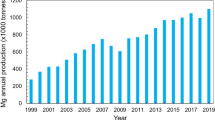Abstract
The development of porous metals has led to the need for an accurate prediction of the physical and mechanical properties of the many possible fabricated structures. For applications where yield stress needs to be reduced, while maintaining a high conductivity, the optimization of the pore dimensions, volume fraction, and pore spacing is required. A finite element model has been developed to simulate the effects of these factors on the electromechanical behavior of porous copper. This model was validated against samples of copper with mechanically induced pores as well as a copper GASAR sample. Good agreement (within an error of ±3%) was shown between the model and experimental data for the resistivity and effective modulus for both the mechanically induced pore and the GASAR samples, although the low ductility of the samples was not predicted and restricts the application of the simulation.











Similar content being viewed by others
References
J. Banhart: Manufacture, characterisation and application of cellular metals and metal foams. Prog. Mater. Sci. 46(6), 559–632 (2001).
L. Drenchev, J. Sobczak, S. Malinov, and W. Sha: Gasars: A class of metallic materials with ordered porosity. Mater. Sci. Technol. 22(10), 1135–1147 (2006).
H. Nakajima: Fabrication, properties and application of porous metals with directional pores. Prog. Mater. Sci. 52(7), 1091–1173 (2007).
H. Bidadi, S. Sobhanian, M. Mazidi, S. Hasanli, and S. Khorram: The peculiarities of mechanical bending of silicon wafers after diverse manufacturing operations. Microelectron. J. 34(5–8), 515–519 (2003).
M. Steinzig: Bend tests of silicon ladders to determine ultimate strength. Hytec Inc. Mechanical/Thermal design Technical Notes (2000).
A. Kee, P. Matic, and L. Popels: A two dimensional computational study of a gasar porous copper microstructure. Mater. Sci. Eng., A 225(1–2), 85–95 (1997).
COMSOL Multiphysics 4.3a, The COMSOL Group (Stockholm, Sweden, 2012).
X. Yang, G.Q. Wu, W. Sha, Q.Q. Zhang, and Z. Huang: Numerical study of the effects of reinforcement/matrix interphase on stress–strain behavior of YAl2 particle reinforced MgLiAl composites. Composites Part A 43(3), 363–369 (2012).
L. Drenchev, J. Sobczak, N. Sobczak, W. Sha, and S. Malinov: A comprehensive model of ordered porosity formation. Acta Mater. 55(19), 6459–6471 (2007).
Acknowledgment
The authors wish to acknowledge the contribution of funding from the FP7 grant (FP7-SME-2012–286943).
Author information
Authors and Affiliations
Corresponding author
Rights and permissions
About this article
Cite this article
Slater, C., Strangwood, M. Modeling the effects of pore arrays on the electrical and mechanical properties of copper. Journal of Materials Research 28, 2539–2544 (2013). https://doi.org/10.1557/jmr.2013.188
Received:
Accepted:
Published:
Issue Date:
DOI: https://doi.org/10.1557/jmr.2013.188




